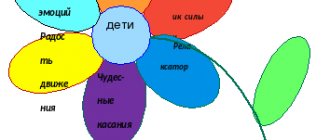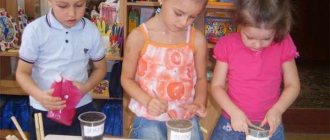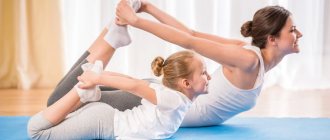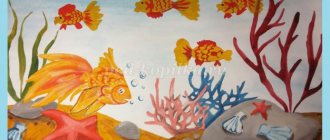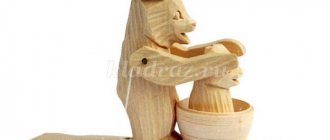Motor mode model for all age groups
Health care – to ensure the protection of the life and promotion of the child’s health. Contribute to the improvement of all functions of the child’s body.
Educational – to form the foundations of physical culture. To form in children initial ideas about healthy lifestyle.
Educational – to cultivate interest in various types of motor activities. To promote the development of positive volitional qualities in the child.
| Motor mode model for all age groups | Junior groups | Middle groups | Senior groups | Preparatory groups |
| Morning exercises | Daily 5-6 min. | Daily 6-8 min. | Daily 8-10 min. | Daily 10-12 min. |
| Physical education minutes | 2-3 min. | 2-3 min. | 2-3 min. | 2-3 min. |
| Music classes | 2 times a week 15 min. | 2 times a week 20 min. | 2 times a week 25 min. | 2 times a week 30 min. |
| Physical education classes (2 indoors, 1 outdoors) | 3 times a week 15 min. | 3 times a week 20 min. | 3 times a week 25 min. | 3 times a week 30 min. |
| Outdoor games: - plot games; - plotless; - fun games; - competitions; - relay races. | Every day at least two games for 5-7 minutes. | Every day at least two games for 7-8 minutes. | Every day at least two games for 8-10 minutes. | Every day at least two games for 10-12 minutes. |
| Health activities: - awakening gymnastics - breathing exercises | Daily 5 min. | Daily 6 min. | Daily 7 min. | Daily 8 min. |
| Physical exercises and game tasks: - articulation gymnastics; — finger gymnastics; - visual gymnastics. | Daily, combining exercises of your choice for 3-5 minutes. | Daily, combining exercises of your choice for 6-8 minutes. | Daily, combining exercises of your choice for 8-10 minutes. | Daily, combining exercises of your choice for 10-15 minutes. |
| Physical education | Once a month up to 15 min. | Once a month up to 20 min. | Once a month up to 30 min. | Once a month up to 40 min |
| Sports festival | 2 times a year up to 30 min. | 2 times a year up to 45 min. | 2 times a year up to 1 hour | 2 times a year up to 1 hour |
| Independent motor activity of children during the day | Daily. The nature and duration depend on the individual characteristics and needs of the children. Conducted under the guidance of a teacher. | |||
Motor mode of the younger group
| Kind of activity | Duration |
| Morning exercises | Daily in a group (in the warm season - on site), 5 min |
| Motor warm-ups | Every day during 10 min. break between classes |
| Physical education minutes | Daily during static exercises, 2-3 min. |
| Outdoor games and exercise while walking | Daily 15-20 min. |
| Individual work on movement development | 2 times a week for a walk of 5-10 minutes. |
| Exercising after a nap | Daily 5-6 min. |
| Physical education classes | 2 times a week for 15 min. |
| Sports walk | 3 times a week for 10 -15 minutes |
| Physical education | Once a quarter, 20-25 min |
| Independent motor activity | Every day, under the guidance of a teacher, indoors and on a walk, the duration depends on the individual characteristics of the children |
Motor mode of the middle group
| Kind of activity | Duration |
| Morning exercises | Daily in a group (in the warm season - on site), 5-6 minutes |
| Motor warm-ups | Every day during a 10-minute break between classes |
| Physical education minutes | Daily during static exercises, 2-3 min. |
| Outdoor games and exercise while walking | Daily 15-20 min. |
| Individual work on movement development | 2 times a week for a walk of 5-10 minutes. |
| Exercising after a nap | Daily 5-6 min. |
| Physical education classes | 2 times a week for 20-25 minutes. |
| Sports walk | 3 times a week for 15-20 minutes |
| Physical education | Once a quarter, 20-25 min |
| Sports holiday | 2 times a year, 45 min. |
| Independent motor activity | Every day, under the guidance of a teacher, indoors and on a walk, the duration depends on the individual characteristics of the children |
Motor mode of the senior group
| Kind of activity | Duration |
| Morning exercises | Daily in a group (in the warm season - on the site), 6-7 min. |
| Motor warm-ups | Every day during a 10-minute break between classes |
| Physical education minutes | Daily during static exercises, 2-3 min. |
| Outdoor games and exercise while walking | Daily 20-25 min. |
| Individual work on movement development | 2 times a week for a 15-minute walk. |
| Exercising after a nap | Daily 5-6 min. |
| Physical education classes | 2 times a week for 30 minutes. |
| Sports walk | 3 times a week for 15-20 minutes. |
| Physical education | Once a month, 30 min |
| Sports holiday | 2 times a year, 1 hour |
| Independent motor activity | Every day, under the guidance of a teacher, indoors and on a walk, the duration depends on the individual characteristics of the children |
Motor mode of the preparatory group
| Kind of activity | Duration |
| Morning exercises | Daily in a group (in the warm season - on site), 6-7 minutes |
| Motor warm-ups | Every day during a 10-minute break between classes |
| Physical education minutes | Daily during static exercises, 2-3 min. |
| Outdoor games and exercise while walking | Daily 20-25 min. |
| Individual work on movement development | 2 times a week for a 15-minute walk. |
| Exercising after a nap | Daily 5-6 min. |
| Physical education classes | 2 times a week for 35 minutes. |
| Sports walk | 3 times a week for 20-25 minutes |
| Physical education | Once a month, 35-40 min. |
| Sports holiday | 2 times a year, 1 hour |
| Independent motor activity | Every day, under the guidance of a teacher, indoors and on a walk, the duration depends on the individual characteristics of the children |
Education and training in the middle group of kindergarten. Program and methodological recommendations
Physical education
Continue work to strengthen children's health, strengthen the body and improve its functions. To develop skills and abilities to correctly perform movements in various forms of organizing children’s motor activity. To cultivate beauty, grace, expressiveness of movements. Develop independence and creativity in motor activities.
Carry out the pedagogical process based on anatomical and physiological indicators of children's development.
Indicators of physical development of children[1]
Physical development of boys from 4 to 5 years old
Physical development of girls from 4 to 5 years old
Physical education and health work
Under the guidance of medical workers, carry out a set of hardening procedures using natural factors (air, sun, water). Ensure that children stay outdoors in accordance with their daily routine.
Do morning exercises every day for 6–8 minutes.
Organize and conduct various sports games and exercises, outdoor games (in winter - sledding, sliding on ice paths, skiing; in the warm season - cycling). If conditions exist, teach children to swim.
Once a month, conduct physical education activities lasting 20 minutes; twice a year - physical education holidays (winter and summer) lasting up to 40–45 minutes.
To teach children to independently and creatively use physical education equipment and attributes for outdoor games during walks.
Physical Culture
Form correct posture.
Develop and improve children’s motor skills and abilities, the ability to creatively use them in independent motor activities.
Strengthen the ability to walk and run with coordinated movements of the arms and legs. Learn to run easily, rhythmically, energetically pushing off with your toes.
Improve the ability to crawl, climb, crawl; climb from one span of the gymnastic wall to another (right, left), through objects.
Learn to push off energetically and land correctly when jumping on two legs in place and moving forward, to navigate in space. In standing long and high jumps, learn to combine take-off with a swing of the arms, and maintain balance when landing. Practice jumping over a short rope.
Strengthen the ability to take the correct starting position when throwing, hit the ball on the ground with your right and left hands, throw and catch it with your hands (without pressing it to your chest).
Learn to ride a two-wheeled bicycle in a straight line, in a circle; skiing at a sliding step, performing turns, climbing a mountain.
Teach formations and maintaining distance while moving.
Develop psychophysical qualities: speed, endurance, flexibility, agility, etc.
Learn to play a leading role in outdoor play and be conscious of following the rules of the game.
In all forms of organizing motor activity, develop in children organization, independence, initiative, creativity, and the ability to maintain friendly relationships with peers.
Basic movements
Walking.
Walking is normal, on toes, on heels, on the outer sides of the feet, walking with high knees, small and wide steps, side steps (to the right and left). Walking in a column one at a time, two at a time (in pairs). Walking in a straight line, in a circle, along the boundaries of the hall, in a snake (between objects), scattered. Walking while performing tasks (sit down, change the position of your hands); walking alternating with running, jumping, changing direction, pace, changing the guide.
Balance exercises.
Walking between lines (distance 10–15 cm), along a line, along a rope (diameter 1.5–3 cm), on a board, gymnastic bench, beam (stepping over objects, turning, with a bag on your head, placing your foot with toes, arms to the sides). Walking on a ribbed board, walking and running up and down on an inclined board (width 15–20 cm, height 30–35 cm).
Stepping over the slats of a ladder raised 20–25 cm from the floor, over a medicine ball (over 5–6 balls placed at a distance from each other), with different hand positions.
Circling in both directions (hands on the belt).
Run.
Running is normal, on your toes, with high knees, small and wide steps. Running in a column (one by one, two by two); running in different directions: in a circle, in a snake (between objects), scattered. Running with a change of pace, with a change of leader. Continuous jogging at a slow pace for 1–1.5 minutes. Running for a distance of 40–60 m at an average speed; shuttle run 3 times 10 m; 20 m run (5.5–6 seconds; by the end of the year).
Crawling, climbing.
Crawling on all fours in a straight line (distance - 10 m), between objects, on a snake, on a horizontal and inclined board, on a bench, on a gymnastic bench on your stomach, pulling yourself up with your arms. Crawling on all fours, leaning on the feet and palms; crawling under a rope, an arc (height 50 cm) with the right and left side forward. Climbing through a hoop, climbing over a beam, a gymnastics bench. Climbing a gymnastic wall (climbing from one flight to another to the right and left).
Jumping.
Jumping in place on two legs (20 jumps 2-3 times, alternating with walking), moving forward (distance 2-3 m), turning in a circle. Jumping: legs together, legs apart, on one leg (on the right and left alternately). Jumping over a line, alternately through 4–5 lines, the distance between which is 40–50 cm. Jumping over 2–3 objects (alternately through each) with a height of 5-10 cm. Jumping from a height of 20–25 cm, in length from a place ( not less than 70 cm). Jumping with a short rope.
Rolling, throwing, catching, throwing.
Rolling balls and hoops between objects. Throwing the ball to each other from below, from behind the head and catching it (at a distance of 1.5 m); throwing the ball with both hands from behind the head and with one hand over obstacles (from a distance of 2 m). Throwing the ball up onto the ground and catching it with both hands (3-4 times in a row), hitting the ball on the ground with the right and left hands (at least 5 times in a row).
Throwing objects at a distance (at least 3.5–6.5 m), at a horizontal target (from a distance of 2–2.5 m) with the right and left hands, at a vertical target (height of the target center 1.5 m) from a distance of 1 .5–2 m.
Drill exercises.
Formation in a column one at a time, in a line, in a circle; formation into a column of two or three; alignment by landmarks; turns right, left, around; opening and closing.
Rhythmic gymnastics.
Performing familiar, previously learned exercises and cyclic movements to music.
General developmental exercises
Exercises for the hands, development and strengthening of the muscles of the shoulder girdle.
Raise your arms forward, to the sides, up (at the same time, alternately), move your arms behind your back from the following positions: arms down, hands on the belt, hands in front of the chest; swing your arms forward and back; perform circular movements with your arms bent at the elbows. Place your hands behind your head, spread them to the sides and lower them.
Raise your arms up through your sides, pressing your back tightly against the back of the chair (against the wall); lift the stick (hoop) up, lower it by the shoulders; clench and unclench your hands; Rotate your hands from the original position of the hand forward, to the sides.
Exercises to develop and strengthen back muscles and spinal flexibility.
Turn to the sides, keeping your hands on your belt, spreading them to the sides; lean forward, touching your toes with your fingers. Bend over while performing the task: putting and picking up objects from different starting positions (legs together, legs apart). Bend to the sides, keeping your hands on your belt. Roll the ball around yourself from the starting position (sitting and kneeling); transfer objects from one hand to another under a raised leg (right and left); while sitting, raise both legs above the floor; raise, bend, straighten and lower your legs to the floor from the starting positions lying on your back, sitting. Turn from your back to your stomach, holding an object in outstretched arms. Raise your arms, shoulders and head outstretched forward while lying on your stomach.
Exercises to develop and strengthen the abdominal and leg muscles.
Rise on your toes; alternately place your foot forward on your heel, on your toe; perform floods; half squats (4–5 times in a row); squats, keeping your hands on your belt, stretching your arms forward to the sides.
Alternately raise your legs with your knees bent. Walk on a stick (on a rope), resting your toes on the floor and your heels on the stick (rope). Grasp and move objects from place to place with your feet.
Static exercises.
Maintaining balance in different poses: standing on your toes, arms up; standing on one leg, hands on the belt.
Sport exercises
Sledging.
Slide down a hill on a sled, climb a mountain with a sled, brake when descending from it.
Slip.
Slide independently along icy paths.
Skiing.
Move on skis along the track with a sliding step. Make turns in place (right and left) by stepping.
Climb the slope with a straight step, half-herringbone (straight and oblique). Ski up to 500 m.
Ski games.
“Carousel in the forest”, “The farther the better”, “Vorotsa”.
Biking.
Ride a three- and two-wheeled bicycle in a straight line, in a circle. Make turns right and left.
Swimming.
Move your legs up and down while sitting in the water. Walk along the bottom on your hands forward and backward (legs extended horizontally). Squatting, immerse yourself in water up to your chin and eyes. Place your face in the water, blow on the water, and plunge your head into it. Try to swim at will.
Water games.
“Herons”, “Lumberjack in the water”, “Carousels”, “Football in the water”, “Run after the ball”, “Show your heels”, “Riding in circles”.
Hydroaerobics.
Continue to teach various movements in the water with and without music.
Outdoor games
Continue to develop children’s motor activity in games with balls, jump ropes, hoops, etc.
Develop psychophysical qualities, spatial orientation. Foster independence and initiative in organizing familiar games with a small group of peers.
Accustom to follow the rules without a reminder from the teacher. Develop children's creative abilities in games (inventing game options, combining movements).
Examples of games
With running.
“Planes”, “Colored cars”, “By the bear in the forest”, “Bird and cat”, “Find yourself a mate”, “Horses”, “Ring the rattle”, “Homeless hare”, “Traps”.
With jumping.
“Hares and the wolf”, “Fox in the hen house”, “The gray bunny is washing his face”.
With crawling and climbing.
“The Shepherd and the Flock”, “Migration of Birds”, “Kittens and Puppies”.
With throwing and catching.
“Toss - catch”, “Knock down the club”, “Ball over the net”.
For orientation in space, for attention.
“Find where it’s hidden”, “Find and remain silent”, “Who left?”, “Hide and seek”.
Folk games.
“At the Bear in the Forest”, etc.
By the end of the year, children can
• Walk and run, observing the correct technique of movements.
• Climb the gymnastic wall without missing the slats, climbing from one flight to another; crawl in different ways: leaning on your hands, knees and toes, on your feet and palms; on your stomach, pulling yourself up with your arms.
• Take the correct starting position when jumping from a standing position, land softly, and long jump from a standing position to a distance of at least 70 cm.
• Catch the ball with your hands from a distance of up to 1.5 m; take the correct starting position when throwing, throw objects in different ways with the right and left hand; hit the ball on the ground (floor) at least five times in a row.
• Perform static and dynamic balance exercises.
• Form a column one at a time, in pairs, in a circle, in a line.
• Slide independently along ice paths (length 5 m).
• Skiing at a sliding step for a distance of up to 500 m, making a turn by stepping, climbing a hill.
• Ride a two-wheeled bicycle, make right and left turns.
• Orientate yourself in space, find the left and right sides.
• Come up with options for outdoor games, perform movements independently and creatively.
• Perform simulation exercises, demonstrating beauty, expressiveness, grace, and plasticity of movements.
Education of cultural and hygienic skills
Continue to instill in children neatness and the habit of taking care of their appearance.
Develop the habit of washing yourself, washing your hands with soap before eating, when dirty, and after using the toilet.
Strengthen the ability to use a comb and handkerchief. Teach children to turn away when coughing and sneezing and to cover their mouth and nose with a handkerchief.
Improve the skills of careful eating: take food little by little, chew well, eat quietly, use cutlery correctly (spoon, fork, knife), napkin, rinse your mouth after eating.
Summary of a physical education lesson, middle group
1 part. Walking in a column one at a time. At the teacher’s signal: “Horses!” - children walk, raising their knees high, hands on the belt (average pace), transition to normal walking. At the signal: “Mice!” walk on your toes, hands behind your head. Walking and running in all directions.
Part 2. General developmental exercises with a hoop.
1. I. p. - leg stand at the width of the foot, hoop down with a grip of the hands from the sides. Bring the hoop forward, up, lower forward, return to the starting position (5 times).
2. I. p. - stand in a hoop, arms along the body. Sit down, take the hoop and lift it to the waist, sit down, put the hoop on the floor, return to the starting position (5-6 times).
3. I. p. - feet shoulder-width apart, hoop in the right hand. arms to the sides, remove the hoop behind your back and transfer it to your left hand; arms to the sides, lower the hoop down (5-6 times).
4. I. p. - SITTING, LEGS apart, hoop in bent arms near the chest. Hoop up, lean forward, touch the floor with the rim of the hoop; straighten up, hoop up, return to the starting position (4-5 times).
5. I. p. - stand with your feet at the width of your feet in front of the hoop, arms arbitrarily along the body. Jumping on two legs around the hoop in both directions, alternating with a short pause (3-4 times).
Main types of movements.
Standing long jump (1 0-12 times).
2. Throwing balls over a cord (8-10 times).
The teacher invites the children to form two lines for standing long jumps and places a cord on the floor. The rubber track (or mat) is rolled out. The main attention is paid to the correct starting position - legs slightly apart, feet parallel, arms pulled back. During the jump, the arms are brought forward, landing on the ENTIRE foot; legs are half bent. The first line performs standing long jumps several times in a row, then the second group performs the exercise (if the group is small, then all children perform the task simultaneously).
Beginning of the form
End of form
The teacher places two stands and pulls the cord at the height of the child’s raised hand (of average height in the group). Children are located on both sides of the cord at a distance of 2 m (can be marked). One group of children holds medium-diameter balls in their hands. On command: “Throw it!” - children throw balls over a cord (method - with two hands from behind the head). Children of the second group catch balls after bouncing on the floor. This is how you alternate between throwing the ball and catching it.
Outdoor game "Homeless Hare". From among the players, a “hunter” is selected, the rest of the children are “hares”, THEY are in “minks” (circles). The number of “burrows” is one less than the number of “hares”. The “hunter” is trying to catch the “hare” who is left without a house. He runs away. He can escape in any “hole” - run into a circle. Now another hare is left without a “mink”, and a “hunter” catches him. If the “hunter” catches (touches) the “hare”, then they change roles. If the “hunter” cannot catch anyone for a long time, another child is chosen for this role.
